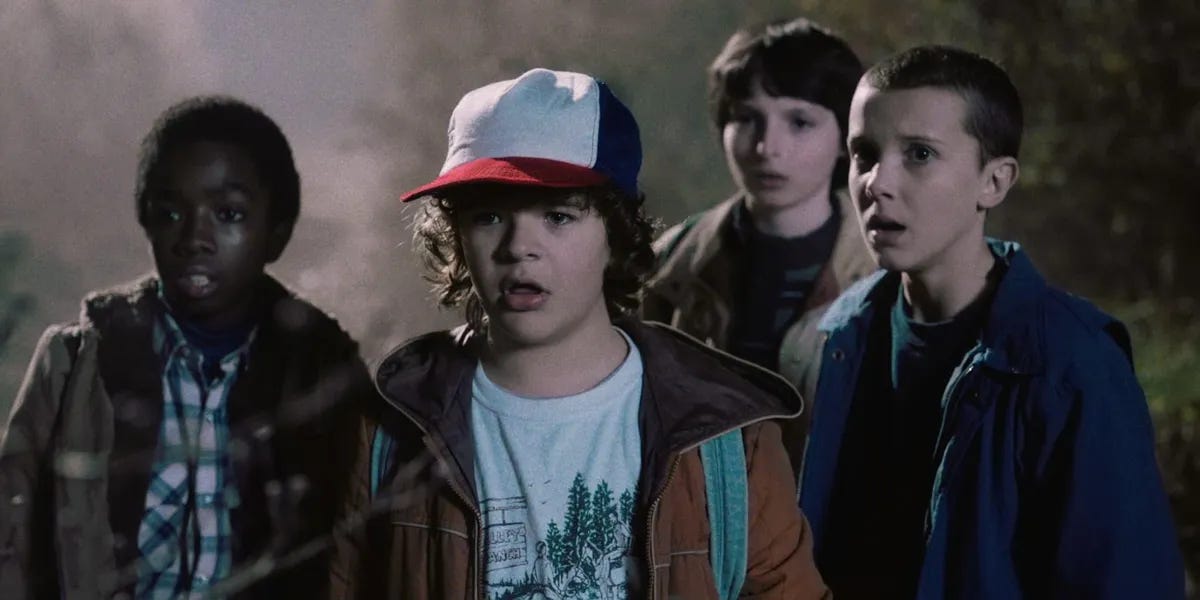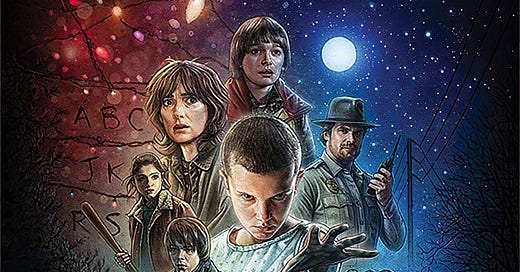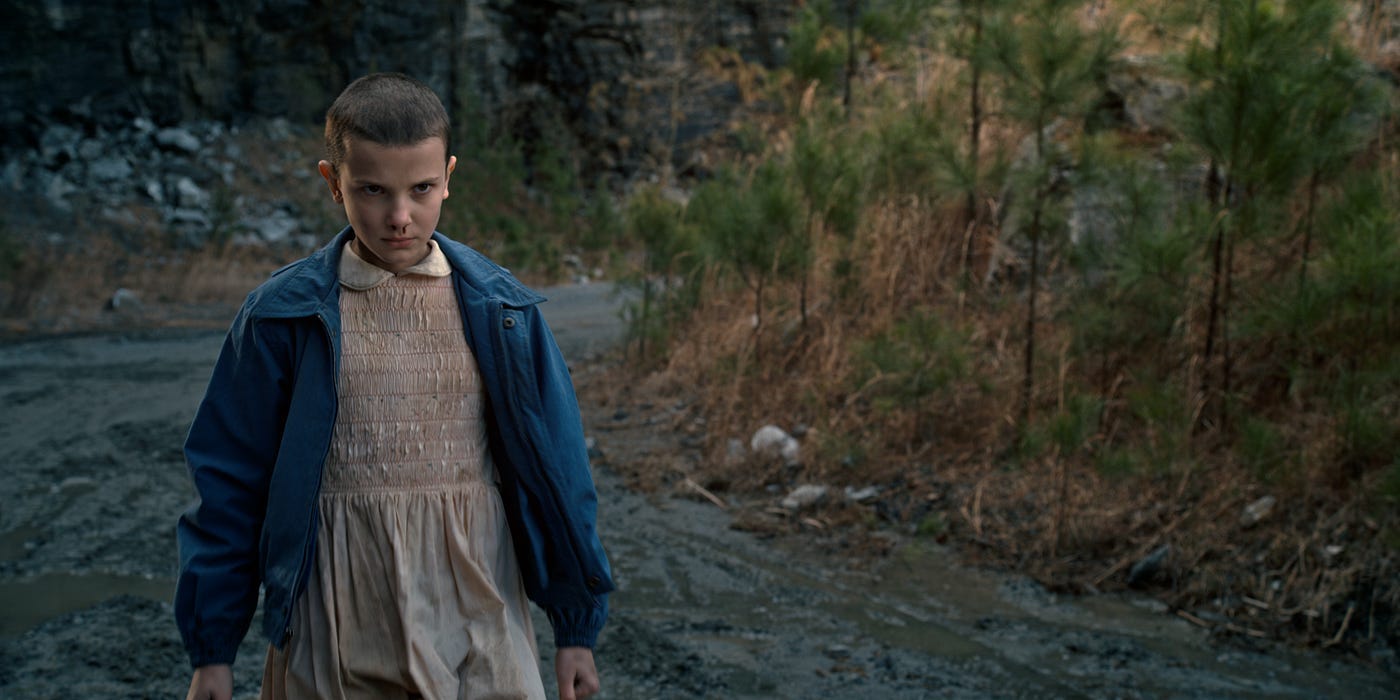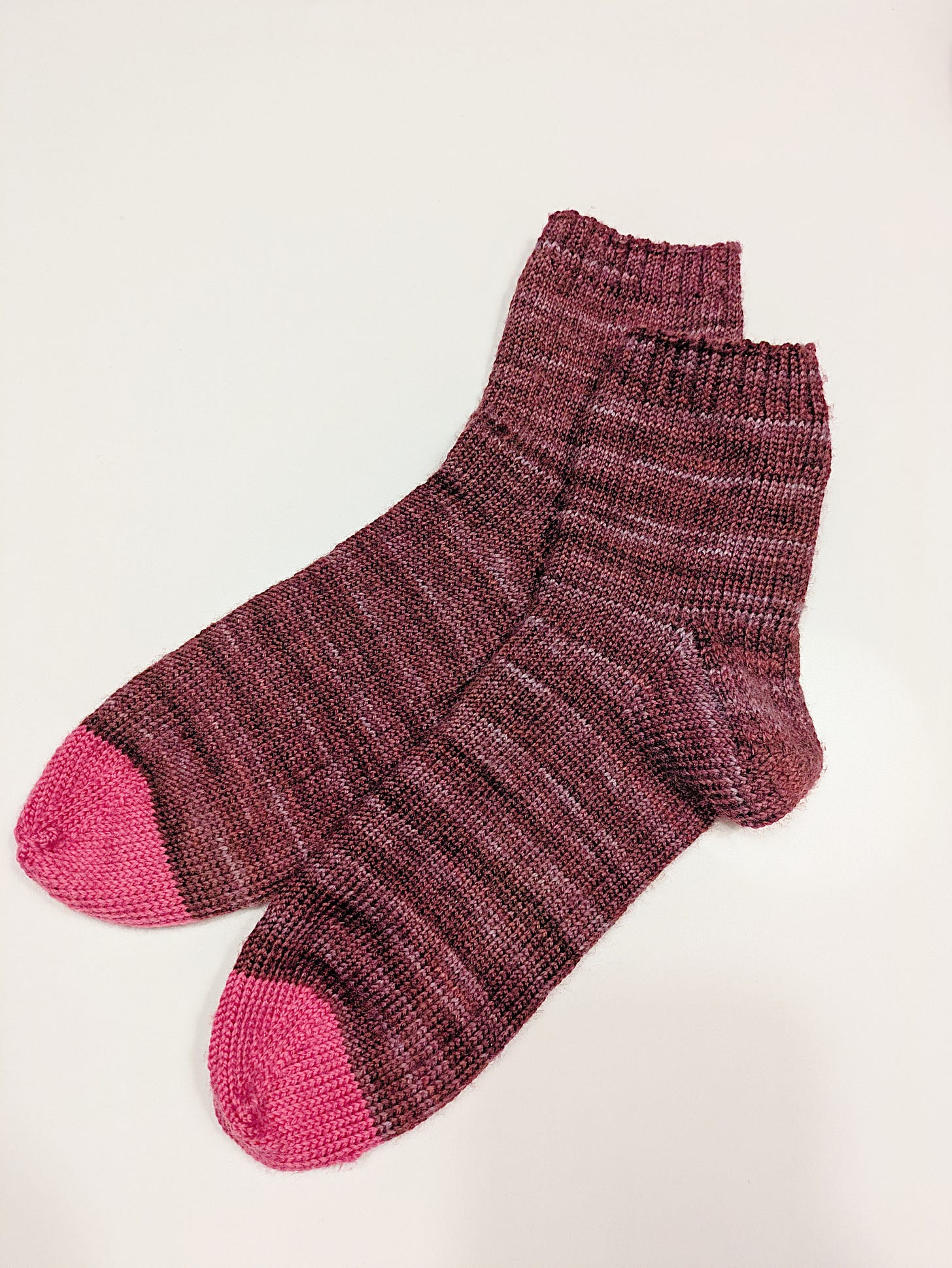I watched Stranger Things. Yes, for the first time.
What makes the show appealing and my critiques of season one
First, please don’t spoil the show. I know I’m eight years late, but I’m asking you, out of the kindness of your heart, to keep it to yourself. That said, this will contain spoilers for the first season.
Second, I have watched the first few episodes before. Probably around the time the third season came out? I can’t remember.
Third, I get it.
Stranger Things is creepy. The costumes are fun. The children are wholesome. The actors are great. The music is nostalgic. If a brother and sister can stop midway through a high-stakes situation to ask if they have crushes and you don’t get sidetracked, something is clearly working.
It’s interesting to come into media so late. In our fast-paced world, I could have and may have stumbled upon dozens of spoilers over the years. That’s the thing with overconsumption, though. I can’t remember what I’ve seen, and the news cycle has long moved on from predictions and analysis of a show whose last season ended two and a half years ago. That’ll soon change with the upcoming season, but for now, my “for you page” is empty of any Stranger Things fan theories.
I went into the first season more or less blind. I know less about Stranger Things than the number of movies I’ve seen Millie Bobby Brown in, which is three. The long short of my experience is I will keep watching, but let’s get into the long long of it.
Gaslighting and Family Dynamics
There is “The Yellow Wallpaper” level gaslighting happening in the first season of Stranger Things. If you haven’t read Charlotte Perkins Gilman’s short story, you should, but the overly simplified conceit is this: a woman with postpartum depression is told by her husband and doctors that she’s hysterical. Instead of treating her as a woman and mother with normal symptoms, they lock her away until even the most sane of us would also be hysterical.
Now that we’re on the same page, back to Stranger Things.

Let’s not even talk about the fake body of Will that is “found” in the quarry and subsequently buried. Let’s say that’s a trope of the thriller part of the show. Joyce Byers is treated like the main character from “The Yellow Wallpaper.” She’s a single mom working at a supermarket that pays so poorly that her oldest son also works to put food on the table. In the first episode, she is ashamed because she doesn’t know where her son is and is belittled by the police when she says he’s missing. She knows he wouldn’t run away and is unlikely to be with his father, yet no one, not even her eldest son, believe her. Joyce says she talks to Will with the lights and through the walls, which, mind you, is concerning, but not a single person even entertains the idea. Joyce is made out to be an underpaid, overworked mom with little control over her children.
In contrast, we are presented with the Wheeler family, a seemingly perfect, suburban, middle-class family in Hawkins, Indiana. They care about their kids, where they are, and with whom. Yet, Steve Herrington has snuck into their house without their knowledge. Their son is harboring a little girl in the basement, and they haven’t a clue. It's just your casual eighties rebellion. Their youngest daughter is clearly old enough to feed herself, yet they treat her like she’s nine months old. (To be fair, that had nothing to do with the story, it just bothered me.) But they believe their children when Nancy says something has happened to her best friend and Will witnesses what he thinks is his friend’s body. Obviously, we see the flaws in their family throughout the season, but overall, the Wheeler family is supposed to be perfect. If that’s not a commentary on socioeconomic status and divorce, I don’t know what is.
In contrast to the Wheeler family who we know backward and forward, we have no idea who Dustin and Lucas’ parents are. We see them at Will’s funeral, but they have no speaking lines. The two boys eat at the Wheeler house for more than one meal, highlighting once again the perfect family whose home is a haven for children other than their own. Hence why Mike feels safe bringing Eleven home and assumes his parents will care for her after the whole ordeal is over—but he won’t be her brother. Don’t get it twisted.
Family is an important dynamic in a show that centers children. It’s not Charlie Brown. Kids’ relationships with their parents, siblings, and friends are crucial. However, there are clear distinctions being made between the Byers and Wheeler families that I think are going to be important moving forward.
Where are all the women?
There aren’t enough women in this show to pass the Bechdel test until Joyce and Eleven interact in the final episode of the season. Up until then, Nancy and Barbara’s school discussions are short, but Steve is a hot topic. If that was all the evidence, it makes sense why Will survives the Upside Down when Barb doesn’t. In contrast, though, Nancy is cast as a badass who has a natural aim with a gun and takes initiative in fighting the Demogorgon. She’s the pretty, popular girl who has so much value that she can change the obnoxious rich kid simply by loving him. Yet, Barb is subject to her best friend’s boyfriend’s friends, dragged along to a party she didn’t want to go to with people she didn’t like. Then she just slips into the Upside Down and barely anyone notices. Even if she isn’t as badass as Nancy, Barb is still a 16-year-old who should have more basic survival instincts if not skills than an 11-year-old.
Yes, this show is set in the eighties, but it wasn’t written in the eighties. The eighties included women. Suburban Indiana included women and girls, so where are they? Why does Nancy have to have Jonathan by her side to do the cool things? Why does Joyce have to have Hopper? Why does Hopper get to presumably be in the know at the end of the season? At least, I guess, the bad man is a man and not the dreaded Disney rendition of a witch. There’s only one bad woman who poses as a social worker several times. Carol isn’t particularly great, but she’s hardly more than a mean girl. Mrs. Wheeler’s trust in the bad man is unsettling, but it’s not altogether villainous. There aren’t a lot of women or girls to give negative roles to, but there should be more women and girls overall.
It’s obvious why Stranger Things launched Netflix into a new wave of Netflix Originals. Only Squid Game comes in at more watched hours. I would say there’s something for everyone, but if you don’t like sci-fi or horror, this is not the show for you. If you even mildly like these genres, though, it’s worth a shot. I’m hoping for more women and a more in-depth look at the Upside Down in future seasons. We will definitely see more of Eleven. I’m not worried about that; it’s the how and who else that concerns me most.
Weekly R.E.P.O.R.T.
Reading: The Full Moon Coffee Shop by Mai Mochizuki
This short novel translated from Japanese is an interesting look at interconnected stories in Kyoto. The main characters are humans who could all use a little perspective when they stumble across a coffee shop that only opens during a full moon. The cafe is run by wise and helpful cats, adding a magical element to the story.
Eating: Baked mac and cheese was my go-to comfort food this week
In continuation of last week’s essay on cooking and recipes, this is one of those meals that doesn’t require a recipe. I used Shelly Westerhausen Worcel’s recipe and Zoe Barrie Soderstrom’s TikTok breakdown of mac and cheese as guides. They’re both cooks I trust and find easy to understand.
Playing: The Culture Study Podcast with host Anne Helen Petersen
Someone posted about this podcast on social media in a round-up of their most-listened-to podcasts of the year. I’ve listened to the three-episode series on romance novels, the episode on cooking I mentioned last week, and an episode about BookTok’s effects on reading. Petersen asks great questions and makes the podcast very engaging for listeners of all knowledge levels.
Obsessing: Socks! In particular, hand-knit socks. I finished my first pair, and I’ve already started my second! If you want to start knitting socks, I highly recommend The Sock Project by Summer Lee.
Recommending: Leaving your house and dressing up for fun. There are a lot of reasons to get dressed up this time of year, but why can’t the coffee shop be one too? Why can’t you dress up to eat dinner with yourself in your own home?
Treating: I’ve been keeping pre-made Christmas sprinkles and chocolate chip Tollhouse cookies in the freezer to make whenever I need a sweet treat.
That’s all she wrote…
Thanks for reading (or skipping) to the end! This newsletter will be coming to your inbox weekly, but you can read previous editions on Substack. In the meantime, feel free to leave any comments, questions, or your own recommendations and life updates. Write you again soon!







